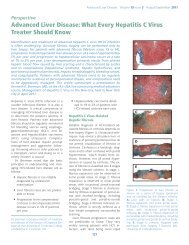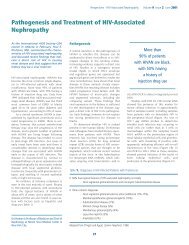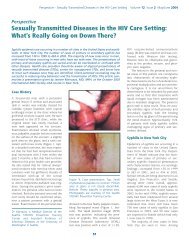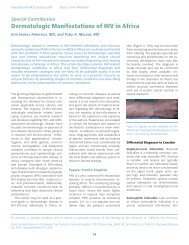Topics in HIV Medicine® - International AIDS Society-USA
Topics in HIV Medicine® - International AIDS Society-USA
Topics in HIV Medicine® - International AIDS Society-USA
You also want an ePaper? Increase the reach of your titles
YUMPU automatically turns print PDFs into web optimized ePapers that Google loves.
<strong>International</strong> <strong>AIDS</strong> <strong>Society</strong>–<strong>USA</strong><br />
<strong>Topics</strong> <strong>in</strong> <strong>HIV</strong> Medic<strong>in</strong>e<br />
Vpu<br />
Vpu genes are conta<strong>in</strong>ed with<strong>in</strong> the<br />
genomes of <strong>HIV</strong>-1 and SIV CPZ ; however,<br />
<strong>HIV</strong>-2 and other SIV l<strong>in</strong>eages may conta<strong>in</strong><br />
a Vpu-like activity with<strong>in</strong> the envelope<br />
glycoprote<strong>in</strong>, at least with regard to<br />
CD4+ down-regulation. Courgnaud and<br />
colleagues (Abstract 73) identified a<br />
novel SIV l<strong>in</strong>eage with a Vpu gene<br />
(SIV MON ). This l<strong>in</strong>eage was identified <strong>in</strong> a<br />
seroprevalence survey of wild-born<br />
monkeys <strong>in</strong> Cameroon and supports the<br />
hypothesis that the SIV CPZ l<strong>in</strong>eage is a<br />
recomb<strong>in</strong>ant of related SIV l<strong>in</strong>eages. Vpu<br />
is a small transmembrane prote<strong>in</strong>,<br />
although the impact of membrane localization<br />
on Vpu activity is not well-understood.<br />
S<strong>in</strong>gh and colleagues (Abstract<br />
212) compared the subcellular localization<br />
of Vpu prote<strong>in</strong>s from <strong>HIV</strong>-1 subtype<br />
B and C isolates. Subtype B Vpu was<br />
localized with<strong>in</strong> the endoplasmic reticulum/Golgi<br />
complex, but subtype C Vpu<br />
was localized at the cell surface, and<br />
the cytoplasmic doma<strong>in</strong> was responsible<br />
for this membrane localization.<br />
Thus, although the Vpu prote<strong>in</strong>s from<br />
subtype C and subtype B viruses may<br />
localize to different cellular compartments,<br />
it rema<strong>in</strong>s to be determ<strong>in</strong>ed<br />
whether the biologic activities of Vpu<br />
from these subtypes exhibit different<br />
biologic properties.<br />
Aspects of Virus Replication<br />
Pre<strong>in</strong>tegration Events<br />
Arguably, one of the least well-understood<br />
events <strong>in</strong> virus replication is the<br />
uncoat<strong>in</strong>g of the viral capsid and release<br />
of viral nucleic acids <strong>in</strong>to the cytoplasm.<br />
Aiken and colleagues (Abstract 17) presented<br />
evidence that the fusogenic activity<br />
of <strong>HIV</strong>-1 envelope glycoprote<strong>in</strong> is<br />
coord<strong>in</strong>ated with <strong>HIV</strong>-1 core maturation.<br />
Immature <strong>HIV</strong>-1 particles were unable to<br />
fuse efficiently with T cells, but truncation<br />
of the gp41 cytoplasmic tail or<br />
cleavage of the gag precursor Pr55 gag<br />
between the MA and NC doma<strong>in</strong>s rescued<br />
fusion. This f<strong>in</strong>d<strong>in</strong>g suggests that<br />
<strong>HIV</strong>-1 fusion is coupled to core maturation<br />
through b<strong>in</strong>d<strong>in</strong>g of the gp41 cytoplasmic<br />
doma<strong>in</strong> to Pr55 gag. This study<br />
provides new targets for the development<br />
of strategies that <strong>in</strong>terrupt <strong>HIV</strong>-1<br />
entry and uncoat<strong>in</strong>g.<br />
Virus entry requires colocalization of<br />
receptors and coreceptors at the po<strong>in</strong>t<br />
of virus contact. Steffens and Hope<br />
(Abstract 20) provided evidence that<br />
receptor and coreceptor molecules<br />
colocalize <strong>in</strong> the region of lipid rafts to<br />
facilitate the <strong>in</strong>teractions that lead up to<br />
<strong>HIV</strong>-1 fusion. The study also found that<br />
receptor and coreceptor molecules<br />
were l<strong>in</strong>ked with act<strong>in</strong>-conta<strong>in</strong><strong>in</strong>g structures.<br />
This f<strong>in</strong>d<strong>in</strong>g may reconcile <strong>in</strong>dependent<br />
observations on the role of the<br />
cytoskeleton and lipid rafts <strong>in</strong> <strong>in</strong>creas<strong>in</strong>g<br />
the efficiency of virus entry.<br />
Several studies were concerned with<br />
analyz<strong>in</strong>g the impact of receptor and<br />
coreceptor density and location on virion<br />
<strong>in</strong>fectivity, susceptibility to entry<br />
<strong>in</strong>hibitors, and resistance to antibodymediated<br />
neutralization. Although<br />
transmembrane envelope glycoprote<strong>in</strong>s<br />
of lentiviruses conta<strong>in</strong> long cytoplasmic<br />
tails, passage of SIV mac <strong>in</strong> human cell<br />
l<strong>in</strong>es selects for variants with truncated<br />
cytoplasmic tails. One study (Abstract<br />
19) demonstrated that truncation of the<br />
cytoplasmic doma<strong>in</strong> of gp41 dramatically<br />
<strong>in</strong>creased envelope content on<br />
virions by 25- to 50-fold. Although the<br />
<strong>in</strong>creased envelope content led to a<br />
modest <strong>in</strong>crease <strong>in</strong> viral <strong>in</strong>fectivity, it<br />
was accompanied by a dramatic reduction<br />
<strong>in</strong> sensitivity to neutraliz<strong>in</strong>g antibody.<br />
Thus, truncation of the gp41 cytoplasmic<br />
tail by <strong>in</strong> vitro passage favors<br />
emergence of variants with <strong>in</strong>creased<br />
<strong>in</strong>fectivity <strong>in</strong> vitro, but evolutionary<br />
pressure for long cytoplasmic doma<strong>in</strong>s<br />
<strong>in</strong> vivo favors <strong>in</strong>creased neutralization<br />
resistance. In a related study (Abstract<br />
23), Reeves and colleagues found that<br />
the density of coreceptor molecules on<br />
target cells <strong>in</strong>fluenced virus susceptibility<br />
to entry <strong>in</strong>hibitors such as enfuvirtide<br />
(T-20) and TAK-779. There was an<br />
<strong>in</strong>verse correlation between coreceptor<br />
expression levels and sensitivity to<br />
enfuvirtide. In addition, there was an<br />
<strong>in</strong>verse correlation between gp120/<br />
coreceptor aff<strong>in</strong>ity and sensitivity to<br />
entry <strong>in</strong>hibitors, presumably because<br />
the more rapid fusion k<strong>in</strong>etics conferred<br />
by greater envelope/coreceptor<br />
aff<strong>in</strong>ity reduces the time dur<strong>in</strong>g which<br />
enfuvirtide is able to <strong>in</strong>teract with the<br />
viral envelope.<br />
A large number of coreceptor<br />
molecules for <strong>HIV</strong>-1 and SIV <strong>in</strong>fection<br />
have been identified, but there is little<br />
def<strong>in</strong>itive <strong>in</strong>formation that coreceptors<br />
other than CCR5 and CXCR4 are directly<br />
<strong>in</strong>volved <strong>in</strong> <strong>HIV</strong>-1 replication and<br />
pathogenesis <strong>in</strong> vivo. Willey and colleagues<br />
(Abstract 273) presented evidence<br />
for an unidentified receptor for<br />
the chemok<strong>in</strong>e vMIP-1 that may serve<br />
as a functional coreceptor for a number<br />
of <strong>HIV</strong>-1 and SIV variants. A subset of<br />
<strong>HIV</strong>-1, <strong>HIV</strong>-2, and SIVs were found to<br />
<strong>in</strong>fect primary endothelial cells and<br />
astrocytes that lack CCR5 and CXCR4<br />
expression by a CD4+-dependent<br />
mechanism that was resistant to<br />
<strong>in</strong>hibitors of CXCR4- and CCR5-dependent<br />
<strong>in</strong>fection. This f<strong>in</strong>d<strong>in</strong>g suggests<br />
the presence of an alternative functional<br />
coreceptor on these cells, which<br />
about 25% of the dual tropic <strong>HIV</strong>-1<br />
stra<strong>in</strong>s tested were able to utilize. In<br />
addition, this coreceptor was active on<br />
primary peripheral blood mononuclear<br />
cells (PBMCs). The ability to block use<br />
of this coreceptor us<strong>in</strong>g vMIP-1 suggests<br />
that a vMIP-1 receptor was<br />
<strong>in</strong>volved. Although CCR8, CXCR6, and<br />
GPR1 all b<strong>in</strong>d vMIP-1, the expression of<br />
these receptors did not correlate with<br />
usage of the alternative coreceptor.<br />
Collectively, this suggests the presence<br />
of an alternative coreceptor, which is<br />
expressed on primary cells and which<br />
may be functionally <strong>in</strong>volved <strong>in</strong> viral<br />
tropism <strong>in</strong> vivo.<br />
Several studies have suggested that<br />
R5 viruses are selectively transmitted.<br />
This result has been <strong>in</strong>terpreted as<br />
suggest<strong>in</strong>g that cells such as macrophages,<br />
where <strong>in</strong>fection is CCR5-<br />
dependent, may be early reservoirs<br />
for the establishment of <strong>in</strong>fection follow<strong>in</strong>g<br />
viral transmission. In order to<br />
ga<strong>in</strong> further <strong>in</strong>sight <strong>in</strong>to the mechanism<br />
of R5 dom<strong>in</strong>ance, Harouse and<br />
colleagues (Abstract 125lb) compared<br />
the transmissibility of pathogenic SIV-<br />
<strong>HIV</strong> hybrid viruses (S<strong>HIV</strong>s) that exhibit<br />
X4 or R5 tropism. Both X4- and R5-specific<br />
S<strong>HIV</strong>s were detectable <strong>in</strong> the plasma<br />
of co<strong>in</strong>fected animals with<strong>in</strong> the<br />
first 3 weeks of <strong>in</strong>fection, but between<br />
3 and 6 weeks, co<strong>in</strong>cident with the<br />
onset of antiviral immunity, R5 viruses<br />
predom<strong>in</strong>ated. When transmission was<br />
compared <strong>in</strong> co<strong>in</strong>fected animals <strong>in</strong><br />
which CD8+ cells had been depleted,<br />
X4 viruses predom<strong>in</strong>ated. This f<strong>in</strong>d<strong>in</strong>g<br />
suggests that R5 viruses predom<strong>in</strong>ate<br />
after transmission because they are<br />
72









